Strategies for Reducing Expenses in Business Operations
VerifiedAdded on 2019/12/17
|9
|1831
|189
Essay
AI Summary
The provided content discusses various ways to reduce costs and increase investment in an entity. The key strategies include bringing innovation, defining operational plans, applying costing techniques, managing expenses, providing free training, reducing COGS expenses, taking grants, encouraging personal finance, and offering long-term interest. Additionally, the article highlights methods to reduce capital expenses such as reducing acquisition of fixed assets, installing assets only when necessary, and using dual technology. It also emphasizes the importance of fixing major defects, selling obsolete assets, and negotiating with distributors. Overall, the content aims to provide practical solutions for entities to manage their expenses effectively.
Contribute Materials
Your contribution can guide someone’s learning journey. Share your
documents today.
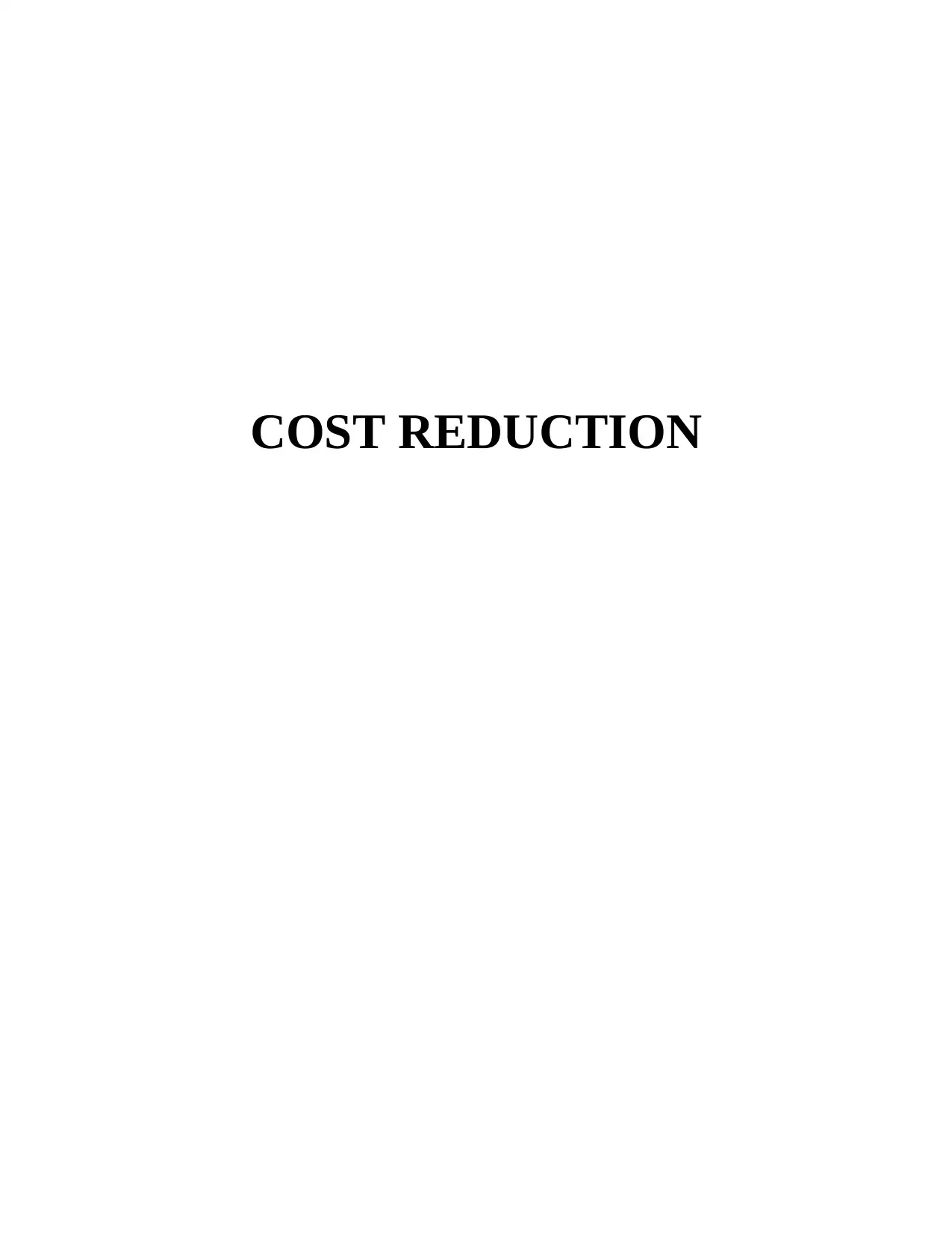
COST REDUCTION
Secure Best Marks with AI Grader
Need help grading? Try our AI Grader for instant feedback on your assignments.

Table of Contents
Labor cost reduction....................................................................................................................3
Operating cost reduction..............................................................................................................5
Capital expenses reduction..........................................................................................................7
REFERENCES................................................................................................................................9
2
Labor cost reduction....................................................................................................................3
Operating cost reduction..............................................................................................................5
Capital expenses reduction..........................................................................................................7
REFERENCES................................................................................................................................9
2
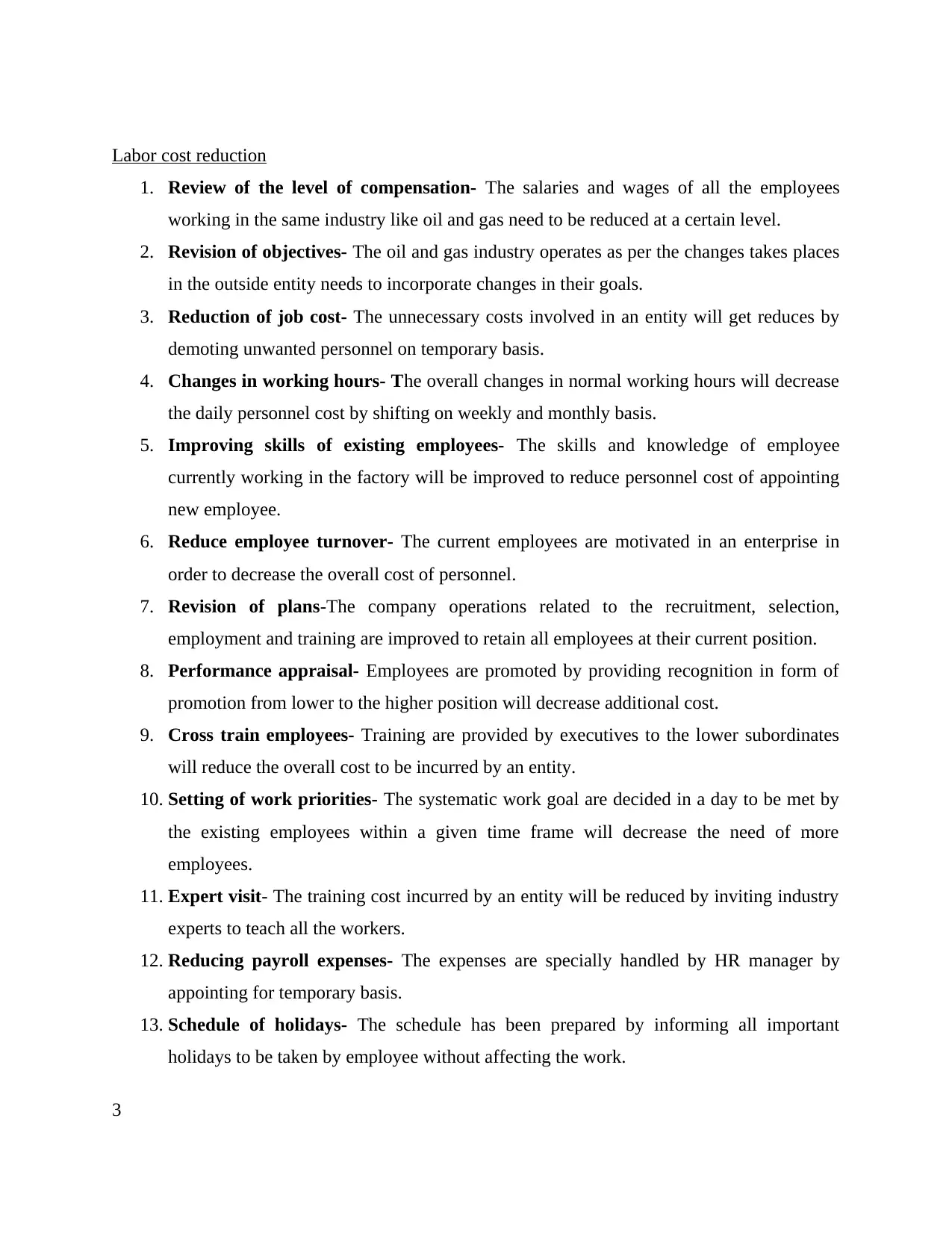
Labor cost reduction
1. Review of the level of compensation- The salaries and wages of all the employees
working in the same industry like oil and gas need to be reduced at a certain level.
2. Revision of objectives- The oil and gas industry operates as per the changes takes places
in the outside entity needs to incorporate changes in their goals.
3. Reduction of job cost- The unnecessary costs involved in an entity will get reduces by
demoting unwanted personnel on temporary basis.
4. Changes in working hours- The overall changes in normal working hours will decrease
the daily personnel cost by shifting on weekly and monthly basis.
5. Improving skills of existing employees- The skills and knowledge of employee
currently working in the factory will be improved to reduce personnel cost of appointing
new employee.
6. Reduce employee turnover- The current employees are motivated in an enterprise in
order to decrease the overall cost of personnel.
7. Revision of plans-The company operations related to the recruitment, selection,
employment and training are improved to retain all employees at their current position.
8. Performance appraisal- Employees are promoted by providing recognition in form of
promotion from lower to the higher position will decrease additional cost.
9. Cross train employees- Training are provided by executives to the lower subordinates
will reduce the overall cost to be incurred by an entity.
10. Setting of work priorities- The systematic work goal are decided in a day to be met by
the existing employees within a given time frame will decrease the need of more
employees.
11. Expert visit- The training cost incurred by an entity will be reduced by inviting industry
experts to teach all the workers.
12. Reducing payroll expenses- The expenses are specially handled by HR manager by
appointing for temporary basis.
13. Schedule of holidays- The schedule has been prepared by informing all important
holidays to be taken by employee without affecting the work.
3
1. Review of the level of compensation- The salaries and wages of all the employees
working in the same industry like oil and gas need to be reduced at a certain level.
2. Revision of objectives- The oil and gas industry operates as per the changes takes places
in the outside entity needs to incorporate changes in their goals.
3. Reduction of job cost- The unnecessary costs involved in an entity will get reduces by
demoting unwanted personnel on temporary basis.
4. Changes in working hours- The overall changes in normal working hours will decrease
the daily personnel cost by shifting on weekly and monthly basis.
5. Improving skills of existing employees- The skills and knowledge of employee
currently working in the factory will be improved to reduce personnel cost of appointing
new employee.
6. Reduce employee turnover- The current employees are motivated in an enterprise in
order to decrease the overall cost of personnel.
7. Revision of plans-The company operations related to the recruitment, selection,
employment and training are improved to retain all employees at their current position.
8. Performance appraisal- Employees are promoted by providing recognition in form of
promotion from lower to the higher position will decrease additional cost.
9. Cross train employees- Training are provided by executives to the lower subordinates
will reduce the overall cost to be incurred by an entity.
10. Setting of work priorities- The systematic work goal are decided in a day to be met by
the existing employees within a given time frame will decrease the need of more
employees.
11. Expert visit- The training cost incurred by an entity will be reduced by inviting industry
experts to teach all the workers.
12. Reducing payroll expenses- The expenses are specially handled by HR manager by
appointing for temporary basis.
13. Schedule of holidays- The schedule has been prepared by informing all important
holidays to be taken by employee without affecting the work.
3
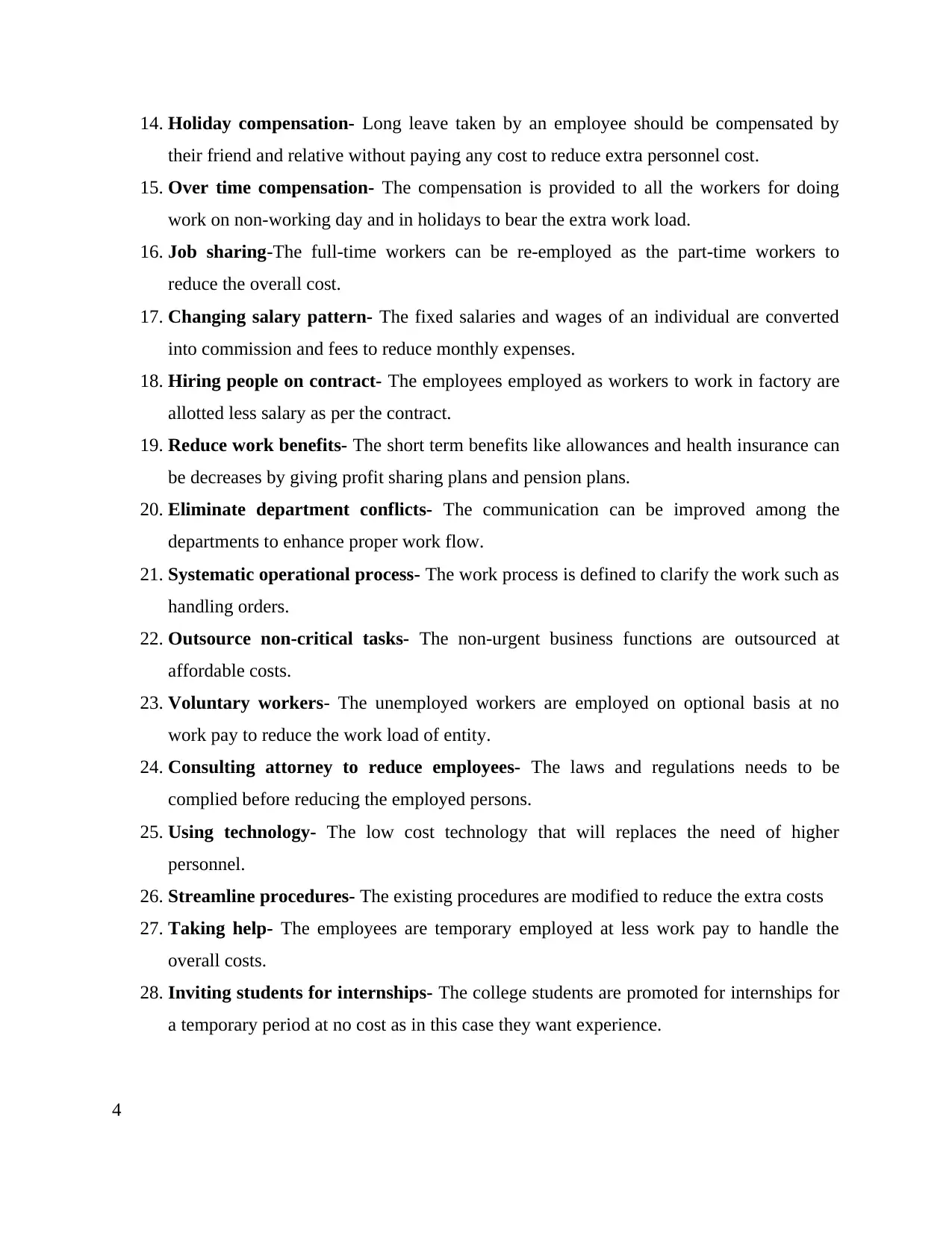
14. Holiday compensation- Long leave taken by an employee should be compensated by
their friend and relative without paying any cost to reduce extra personnel cost.
15. Over time compensation- The compensation is provided to all the workers for doing
work on non-working day and in holidays to bear the extra work load.
16. Job sharing-The full-time workers can be re-employed as the part-time workers to
reduce the overall cost.
17. Changing salary pattern- The fixed salaries and wages of an individual are converted
into commission and fees to reduce monthly expenses.
18. Hiring people on contract- The employees employed as workers to work in factory are
allotted less salary as per the contract.
19. Reduce work benefits- The short term benefits like allowances and health insurance can
be decreases by giving profit sharing plans and pension plans.
20. Eliminate department conflicts- The communication can be improved among the
departments to enhance proper work flow.
21. Systematic operational process- The work process is defined to clarify the work such as
handling orders.
22. Outsource non-critical tasks- The non-urgent business functions are outsourced at
affordable costs.
23. Voluntary workers- The unemployed workers are employed on optional basis at no
work pay to reduce the work load of entity.
24. Consulting attorney to reduce employees- The laws and regulations needs to be
complied before reducing the employed persons.
25. Using technology- The low cost technology that will replaces the need of higher
personnel.
26. Streamline procedures- The existing procedures are modified to reduce the extra costs
27. Taking help- The employees are temporary employed at less work pay to handle the
overall costs.
28. Inviting students for internships- The college students are promoted for internships for
a temporary period at no cost as in this case they want experience.
4
their friend and relative without paying any cost to reduce extra personnel cost.
15. Over time compensation- The compensation is provided to all the workers for doing
work on non-working day and in holidays to bear the extra work load.
16. Job sharing-The full-time workers can be re-employed as the part-time workers to
reduce the overall cost.
17. Changing salary pattern- The fixed salaries and wages of an individual are converted
into commission and fees to reduce monthly expenses.
18. Hiring people on contract- The employees employed as workers to work in factory are
allotted less salary as per the contract.
19. Reduce work benefits- The short term benefits like allowances and health insurance can
be decreases by giving profit sharing plans and pension plans.
20. Eliminate department conflicts- The communication can be improved among the
departments to enhance proper work flow.
21. Systematic operational process- The work process is defined to clarify the work such as
handling orders.
22. Outsource non-critical tasks- The non-urgent business functions are outsourced at
affordable costs.
23. Voluntary workers- The unemployed workers are employed on optional basis at no
work pay to reduce the work load of entity.
24. Consulting attorney to reduce employees- The laws and regulations needs to be
complied before reducing the employed persons.
25. Using technology- The low cost technology that will replaces the need of higher
personnel.
26. Streamline procedures- The existing procedures are modified to reduce the extra costs
27. Taking help- The employees are temporary employed at less work pay to handle the
overall costs.
28. Inviting students for internships- The college students are promoted for internships for
a temporary period at no cost as in this case they want experience.
4
Secure Best Marks with AI Grader
Need help grading? Try our AI Grader for instant feedback on your assignments.

29. Extracting good and bad costs- The costs are filtrated on a criterion of good or bad to
eliminate unnecessary costs.
30. Negotiate with suppliers- The suppliers are selecting by organizing events to select least
expensive suppliers.
31. Ensuring staff efficiency- The workers are allotted with tasks to increase the sales.
32. Increased labor efficiency- The labor efficiency are enhanced by segmented into skilled
and unskilled workers.
33. Workforce optimization- Reducing unnecessary work to be done at the workplace.
34. Reducing working delays- The breaks and tea breaks are avoided by setting time limit.
35. Restricting check in time -The check in time in the entity will be imposed to deduct
expenses from the salary of employee for loss of every 5 minutes.
36. Restricting half days- Taking frequent half days in a week will reduce its efficiency.
37. Offering work from homes- Offering work from home to all ex employee.
38. Offering part-time work- Home maker and students are offered with daily routine work
from home.
39. Informing corporate culture- The company culture are set according to all the
employees.
40. Deduction of higher Provident fund- The higher value deducted will decrease the
current expenses.
41. Increasing communication- Open sessions are conducted to convince all workers to
support the entity.
42. Amending labor policies- The higher compliance with all the policies will reduce costs.
43. Increasing work quality- The quality of the employees will be enhanced.
44. Employing alternative employees- The work is divided into different shifts.
45. Preparation of cost reports- These reports will be prepared to ascertain the true
positions
Operating cost reduction
1. Reducing rent- The rent will be reduces by taking fewer premises
2. Setting cost cutting goal- The goal that support in increasing sales are promoted
3. Re-evaluate suppliers- Prioritizing suppliers on timely basis and cost
5
eliminate unnecessary costs.
30. Negotiate with suppliers- The suppliers are selecting by organizing events to select least
expensive suppliers.
31. Ensuring staff efficiency- The workers are allotted with tasks to increase the sales.
32. Increased labor efficiency- The labor efficiency are enhanced by segmented into skilled
and unskilled workers.
33. Workforce optimization- Reducing unnecessary work to be done at the workplace.
34. Reducing working delays- The breaks and tea breaks are avoided by setting time limit.
35. Restricting check in time -The check in time in the entity will be imposed to deduct
expenses from the salary of employee for loss of every 5 minutes.
36. Restricting half days- Taking frequent half days in a week will reduce its efficiency.
37. Offering work from homes- Offering work from home to all ex employee.
38. Offering part-time work- Home maker and students are offered with daily routine work
from home.
39. Informing corporate culture- The company culture are set according to all the
employees.
40. Deduction of higher Provident fund- The higher value deducted will decrease the
current expenses.
41. Increasing communication- Open sessions are conducted to convince all workers to
support the entity.
42. Amending labor policies- The higher compliance with all the policies will reduce costs.
43. Increasing work quality- The quality of the employees will be enhanced.
44. Employing alternative employees- The work is divided into different shifts.
45. Preparation of cost reports- These reports will be prepared to ascertain the true
positions
Operating cost reduction
1. Reducing rent- The rent will be reduces by taking fewer premises
2. Setting cost cutting goal- The goal that support in increasing sales are promoted
3. Re-evaluate suppliers- Prioritizing suppliers on timely basis and cost
5
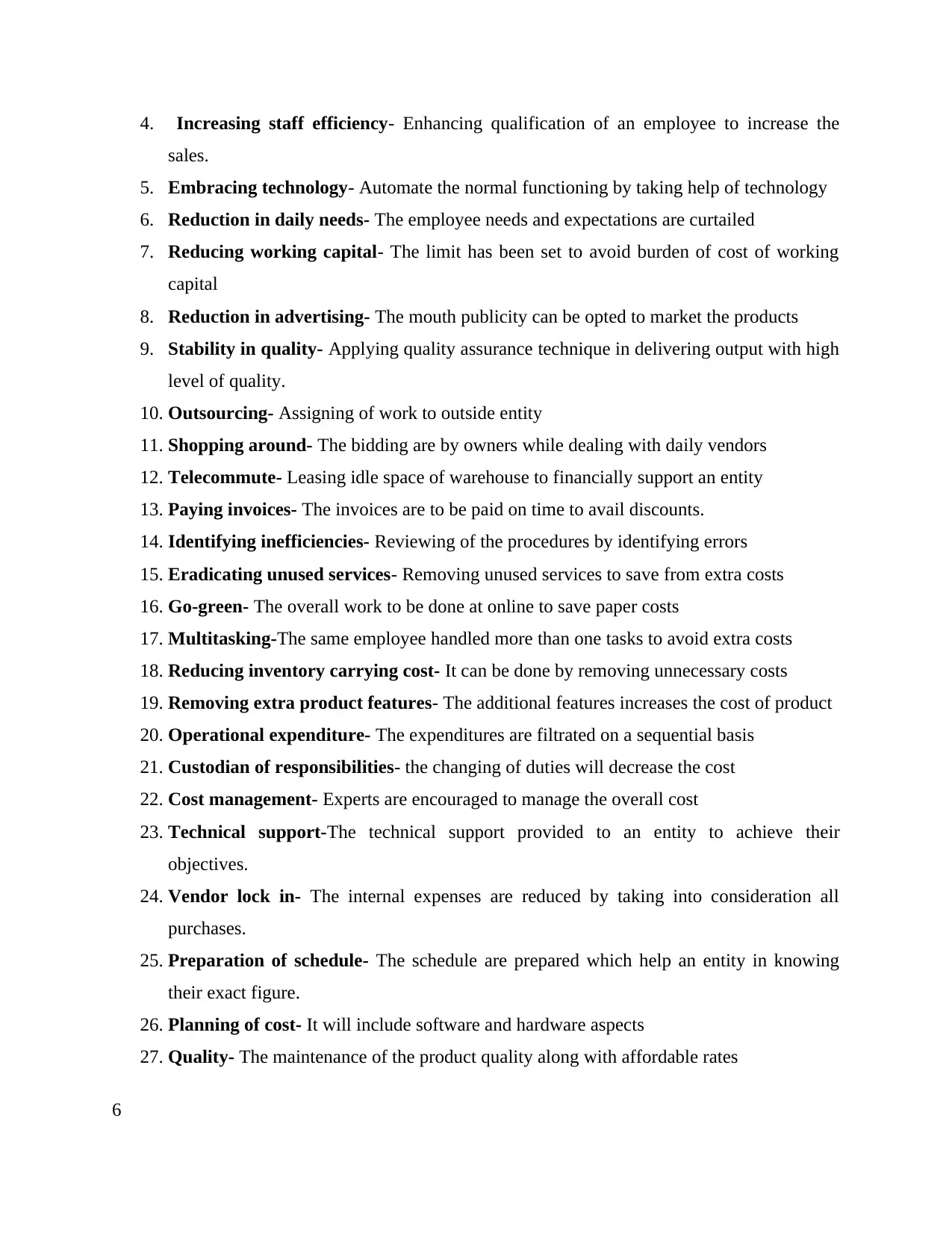
4. Increasing staff efficiency- Enhancing qualification of an employee to increase the
sales.
5. Embracing technology- Automate the normal functioning by taking help of technology
6. Reduction in daily needs- The employee needs and expectations are curtailed
7. Reducing working capital- The limit has been set to avoid burden of cost of working
capital
8. Reduction in advertising- The mouth publicity can be opted to market the products
9. Stability in quality- Applying quality assurance technique in delivering output with high
level of quality.
10. Outsourcing- Assigning of work to outside entity
11. Shopping around- The bidding are by owners while dealing with daily vendors
12. Telecommute- Leasing idle space of warehouse to financially support an entity
13. Paying invoices- The invoices are to be paid on time to avail discounts.
14. Identifying inefficiencies- Reviewing of the procedures by identifying errors
15. Eradicating unused services- Removing unused services to save from extra costs
16. Go-green- The overall work to be done at online to save paper costs
17. Multitasking-The same employee handled more than one tasks to avoid extra costs
18. Reducing inventory carrying cost- It can be done by removing unnecessary costs
19. Removing extra product features- The additional features increases the cost of product
20. Operational expenditure- The expenditures are filtrated on a sequential basis
21. Custodian of responsibilities- the changing of duties will decrease the cost
22. Cost management- Experts are encouraged to manage the overall cost
23. Technical support-The technical support provided to an entity to achieve their
objectives.
24. Vendor lock in- The internal expenses are reduced by taking into consideration all
purchases.
25. Preparation of schedule- The schedule are prepared which help an entity in knowing
their exact figure.
26. Planning of cost- It will include software and hardware aspects
27. Quality- The maintenance of the product quality along with affordable rates
6
sales.
5. Embracing technology- Automate the normal functioning by taking help of technology
6. Reduction in daily needs- The employee needs and expectations are curtailed
7. Reducing working capital- The limit has been set to avoid burden of cost of working
capital
8. Reduction in advertising- The mouth publicity can be opted to market the products
9. Stability in quality- Applying quality assurance technique in delivering output with high
level of quality.
10. Outsourcing- Assigning of work to outside entity
11. Shopping around- The bidding are by owners while dealing with daily vendors
12. Telecommute- Leasing idle space of warehouse to financially support an entity
13. Paying invoices- The invoices are to be paid on time to avail discounts.
14. Identifying inefficiencies- Reviewing of the procedures by identifying errors
15. Eradicating unused services- Removing unused services to save from extra costs
16. Go-green- The overall work to be done at online to save paper costs
17. Multitasking-The same employee handled more than one tasks to avoid extra costs
18. Reducing inventory carrying cost- It can be done by removing unnecessary costs
19. Removing extra product features- The additional features increases the cost of product
20. Operational expenditure- The expenditures are filtrated on a sequential basis
21. Custodian of responsibilities- the changing of duties will decrease the cost
22. Cost management- Experts are encouraged to manage the overall cost
23. Technical support-The technical support provided to an entity to achieve their
objectives.
24. Vendor lock in- The internal expenses are reduced by taking into consideration all
purchases.
25. Preparation of schedule- The schedule are prepared which help an entity in knowing
their exact figure.
26. Planning of cost- It will include software and hardware aspects
27. Quality- The maintenance of the product quality along with affordable rates
6
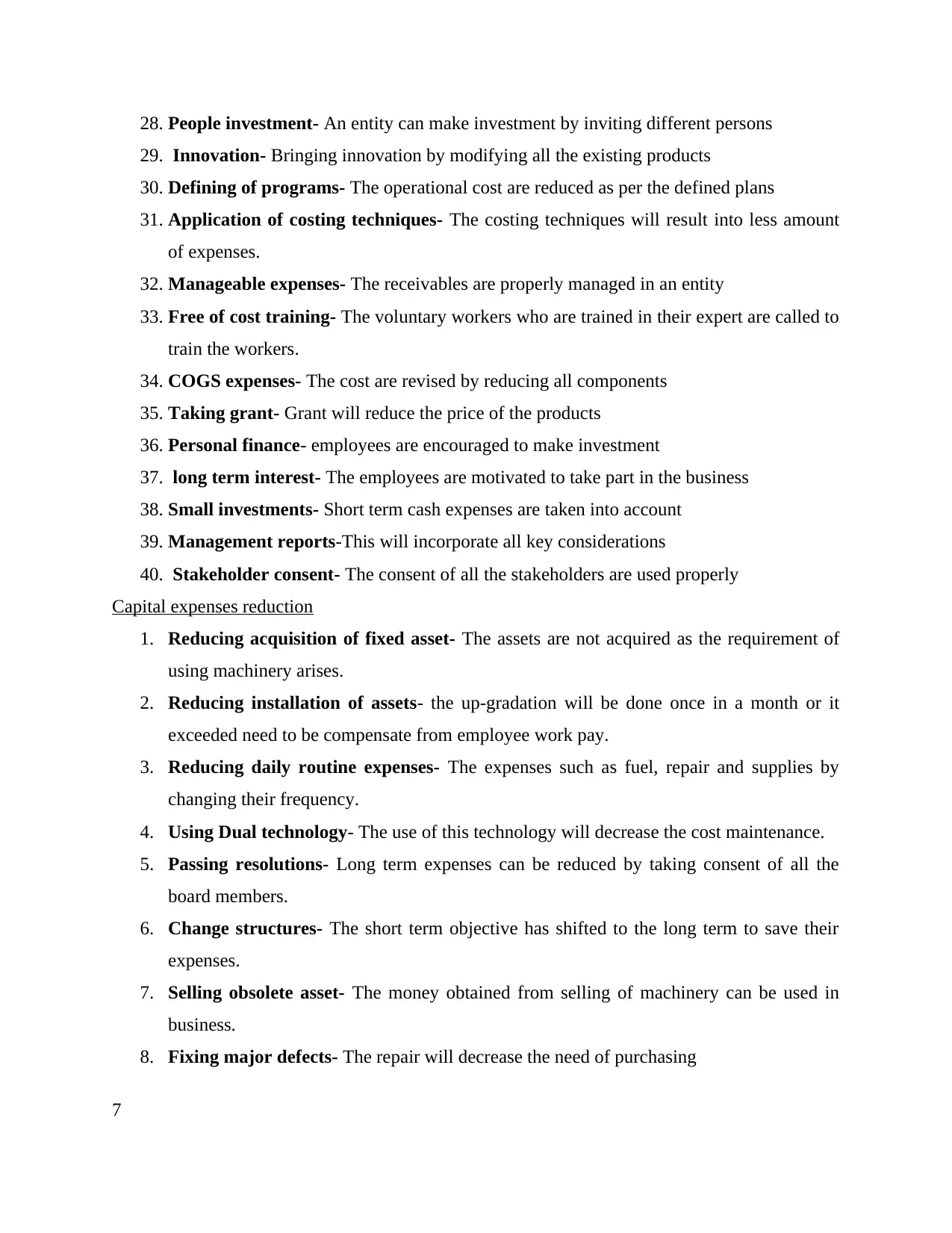
28. People investment- An entity can make investment by inviting different persons
29. Innovation- Bringing innovation by modifying all the existing products
30. Defining of programs- The operational cost are reduced as per the defined plans
31. Application of costing techniques- The costing techniques will result into less amount
of expenses.
32. Manageable expenses- The receivables are properly managed in an entity
33. Free of cost training- The voluntary workers who are trained in their expert are called to
train the workers.
34. COGS expenses- The cost are revised by reducing all components
35. Taking grant- Grant will reduce the price of the products
36. Personal finance- employees are encouraged to make investment
37. long term interest- The employees are motivated to take part in the business
38. Small investments- Short term cash expenses are taken into account
39. Management reports-This will incorporate all key considerations
40. Stakeholder consent- The consent of all the stakeholders are used properly
Capital expenses reduction
1. Reducing acquisition of fixed asset- The assets are not acquired as the requirement of
using machinery arises.
2. Reducing installation of assets- the up-gradation will be done once in a month or it
exceeded need to be compensate from employee work pay.
3. Reducing daily routine expenses- The expenses such as fuel, repair and supplies by
changing their frequency.
4. Using Dual technology- The use of this technology will decrease the cost maintenance.
5. Passing resolutions- Long term expenses can be reduced by taking consent of all the
board members.
6. Change structures- The short term objective has shifted to the long term to save their
expenses.
7. Selling obsolete asset- The money obtained from selling of machinery can be used in
business.
8. Fixing major defects- The repair will decrease the need of purchasing
7
29. Innovation- Bringing innovation by modifying all the existing products
30. Defining of programs- The operational cost are reduced as per the defined plans
31. Application of costing techniques- The costing techniques will result into less amount
of expenses.
32. Manageable expenses- The receivables are properly managed in an entity
33. Free of cost training- The voluntary workers who are trained in their expert are called to
train the workers.
34. COGS expenses- The cost are revised by reducing all components
35. Taking grant- Grant will reduce the price of the products
36. Personal finance- employees are encouraged to make investment
37. long term interest- The employees are motivated to take part in the business
38. Small investments- Short term cash expenses are taken into account
39. Management reports-This will incorporate all key considerations
40. Stakeholder consent- The consent of all the stakeholders are used properly
Capital expenses reduction
1. Reducing acquisition of fixed asset- The assets are not acquired as the requirement of
using machinery arises.
2. Reducing installation of assets- the up-gradation will be done once in a month or it
exceeded need to be compensate from employee work pay.
3. Reducing daily routine expenses- The expenses such as fuel, repair and supplies by
changing their frequency.
4. Using Dual technology- The use of this technology will decrease the cost maintenance.
5. Passing resolutions- Long term expenses can be reduced by taking consent of all the
board members.
6. Change structures- The short term objective has shifted to the long term to save their
expenses.
7. Selling obsolete asset- The money obtained from selling of machinery can be used in
business.
8. Fixing major defects- The repair will decrease the need of purchasing
7
Paraphrase This Document
Need a fresh take? Get an instant paraphrase of this document with our AI Paraphraser
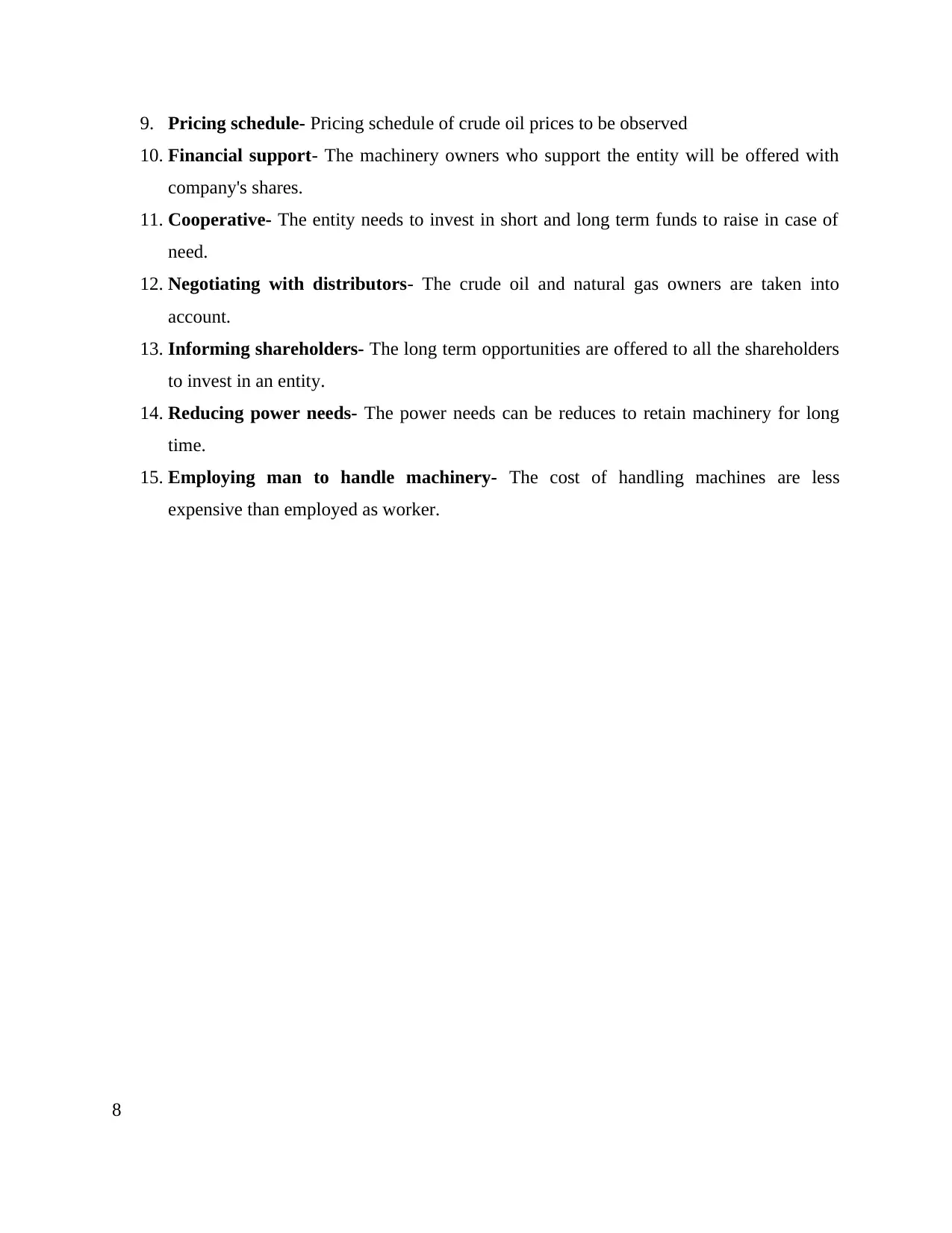
9. Pricing schedule- Pricing schedule of crude oil prices to be observed
10. Financial support- The machinery owners who support the entity will be offered with
company's shares.
11. Cooperative- The entity needs to invest in short and long term funds to raise in case of
need.
12. Negotiating with distributors- The crude oil and natural gas owners are taken into
account.
13. Informing shareholders- The long term opportunities are offered to all the shareholders
to invest in an entity.
14. Reducing power needs- The power needs can be reduces to retain machinery for long
time.
15. Employing man to handle machinery- The cost of handling machines are less
expensive than employed as worker.
8
10. Financial support- The machinery owners who support the entity will be offered with
company's shares.
11. Cooperative- The entity needs to invest in short and long term funds to raise in case of
need.
12. Negotiating with distributors- The crude oil and natural gas owners are taken into
account.
13. Informing shareholders- The long term opportunities are offered to all the shareholders
to invest in an entity.
14. Reducing power needs- The power needs can be reduces to retain machinery for long
time.
15. Employing man to handle machinery- The cost of handling machines are less
expensive than employed as worker.
8
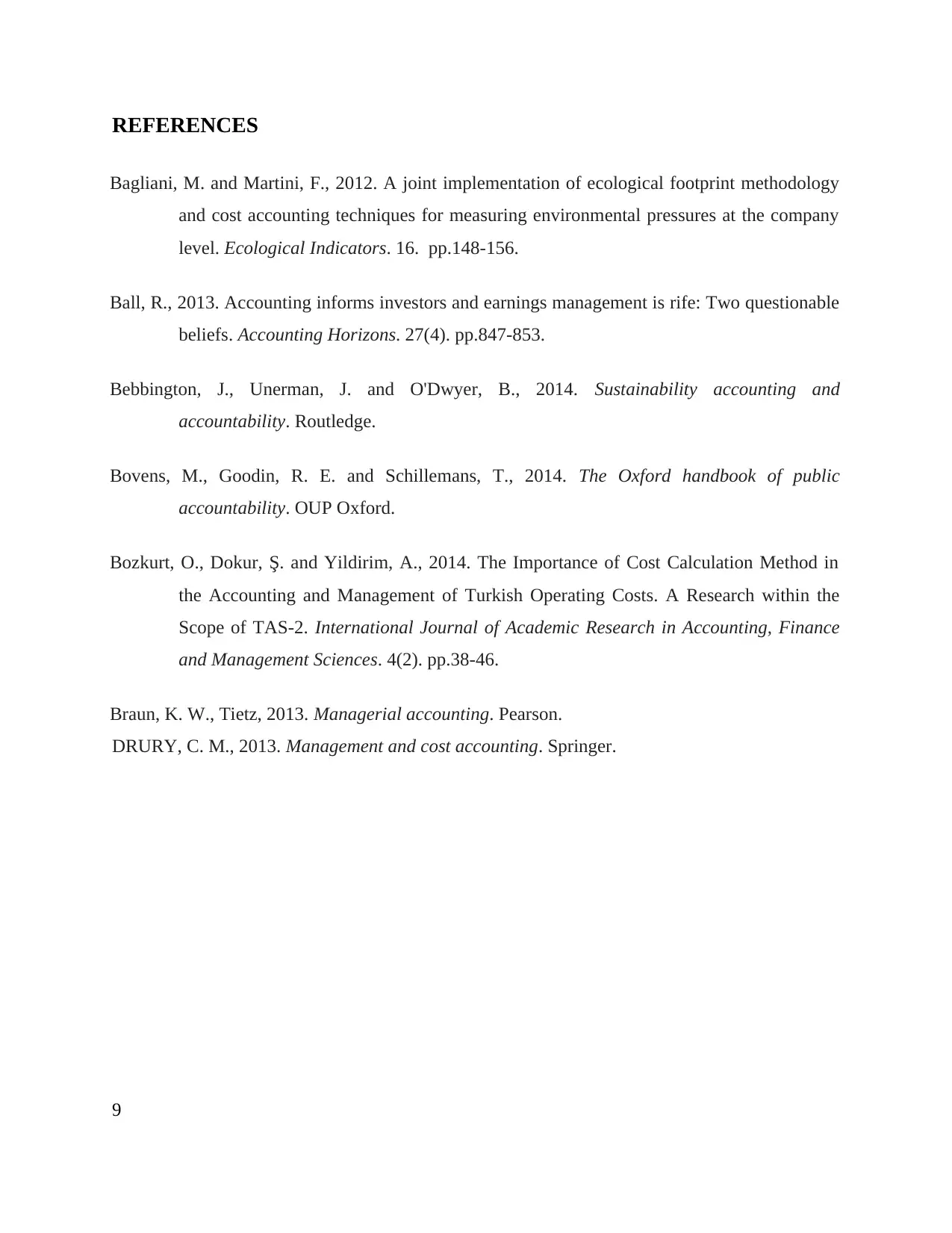
REFERENCES
Bagliani, M. and Martini, F., 2012. A joint implementation of ecological footprint methodology
and cost accounting techniques for measuring environmental pressures at the company
level. Ecological Indicators. 16. pp.148-156.
Ball, R., 2013. Accounting informs investors and earnings management is rife: Two questionable
beliefs. Accounting Horizons. 27(4). pp.847-853.
Bebbington, J., Unerman, J. and O'Dwyer, B., 2014. Sustainability accounting and
accountability. Routledge.
Bovens, M., Goodin, R. E. and Schillemans, T., 2014. The Oxford handbook of public
accountability. OUP Oxford.
Bozkurt, O., Dokur, Ş. and Yildirim, A., 2014. The Importance of Cost Calculation Method in
the Accounting and Management of Turkish Operating Costs. A Research within the
Scope of TAS-2. International Journal of Academic Research in Accounting, Finance
and Management Sciences. 4(2). pp.38-46.
Braun, K. W., Tietz, 2013. Managerial accounting. Pearson.
DRURY, C. M., 2013. Management and cost accounting. Springer.
9
Bagliani, M. and Martini, F., 2012. A joint implementation of ecological footprint methodology
and cost accounting techniques for measuring environmental pressures at the company
level. Ecological Indicators. 16. pp.148-156.
Ball, R., 2013. Accounting informs investors and earnings management is rife: Two questionable
beliefs. Accounting Horizons. 27(4). pp.847-853.
Bebbington, J., Unerman, J. and O'Dwyer, B., 2014. Sustainability accounting and
accountability. Routledge.
Bovens, M., Goodin, R. E. and Schillemans, T., 2014. The Oxford handbook of public
accountability. OUP Oxford.
Bozkurt, O., Dokur, Ş. and Yildirim, A., 2014. The Importance of Cost Calculation Method in
the Accounting and Management of Turkish Operating Costs. A Research within the
Scope of TAS-2. International Journal of Academic Research in Accounting, Finance
and Management Sciences. 4(2). pp.38-46.
Braun, K. W., Tietz, 2013. Managerial accounting. Pearson.
DRURY, C. M., 2013. Management and cost accounting. Springer.
9
1 out of 9
Your All-in-One AI-Powered Toolkit for Academic Success.
+13062052269
info@desklib.com
Available 24*7 on WhatsApp / Email
![[object Object]](/_next/static/media/star-bottom.7253800d.svg)
Unlock your academic potential
© 2024 | Zucol Services PVT LTD | All rights reserved.



